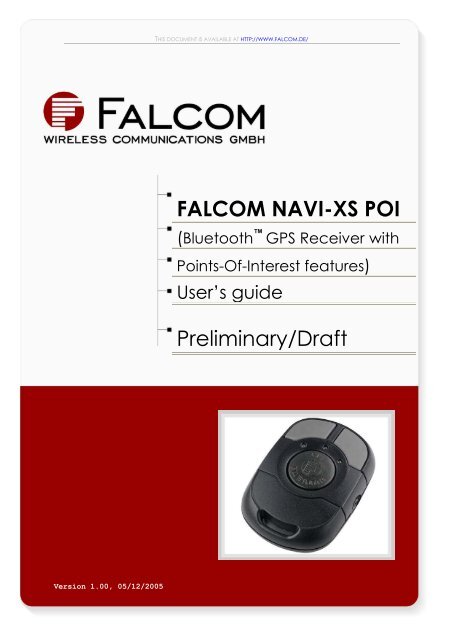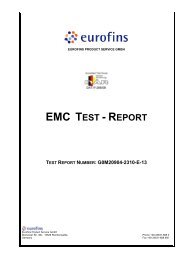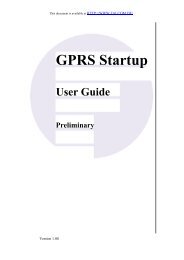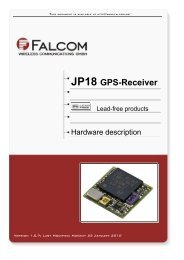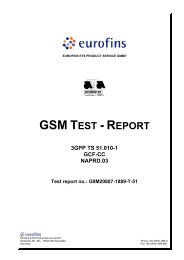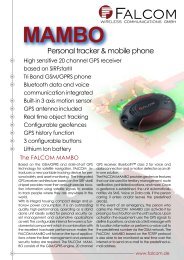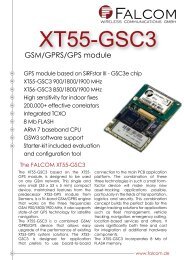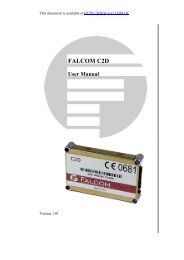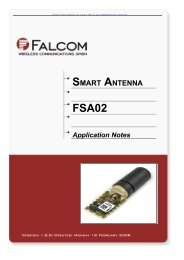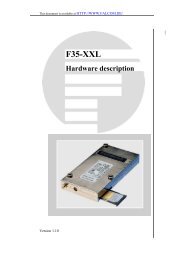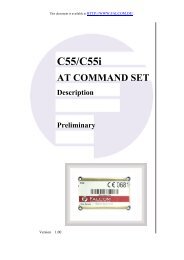FALCOM NAVI-XS POI
FALCOM NAVI-XS POI
FALCOM NAVI-XS POI
Create successful ePaper yourself
Turn your PDF publications into a flip-book with our unique Google optimized e-Paper software.
Version 1.00, 05/12/2005<br />
THIS DOCUMENT IS AVAILABLE AT HTTP://WWW.<strong>FALCOM</strong>.DE/<br />
<strong>FALCOM</strong> <strong>NAVI</strong>-<strong>XS</strong> <strong>POI</strong><br />
(Bluetooth GPS Receiver with<br />
Points-Of-Interest features)<br />
User’s guide<br />
Preliminary/Draft
<strong>NAVI</strong>-<strong>XS</strong> <strong>POI</strong> USER’S GUIDE VERSION 1.00<br />
Table of contents<br />
0 INTRODUCTION .........................................................................4<br />
0.1 GENERAL ABOUT <strong>NAVI</strong>-<strong>XS</strong> <strong>POI</strong> ............................................................................................... 4<br />
0.2 PACKAGE CONTENTS................................................................................................................ 5<br />
0.2.1 Accessories ........................................................................................................................... 6<br />
1 SECURITY ..................................................................................7<br />
1.1 GENERAL INFORMATION ........................................................................................................... 7<br />
1.2 RESTRICTED USE ..................................................................................................................... 7<br />
1.3 CHILDREN ............................................................................................................................... 7<br />
1.4 DRIVING AND SAFETY ............................................................................................................... 7<br />
1.5 BATTERY SAFETY..................................................................................................................... 7<br />
2 TECHNICAL DESCRIPTION ......................................................9<br />
2.1 BLUETOOTH GPS RECEIVER ARCHITECTURE......................................................................... 9<br />
2.2 TECHNICAL SPECIFICATIONS ..................................................................................................... 9<br />
2.2.1 Electrical Characteristics ....................................................................................................... 9<br />
2.2.1.1 General ............................................................................................................................................. 9<br />
2.2.1.2 Accuracy ........................................................................................................................................... 9<br />
2.2.1.3 Datum ............................................................................................................................................. 10<br />
2.2.1.4 Time to First Position ...................................................................................................................... 10<br />
2.2.1.5 <strong>POI</strong> (Point-Of-Interest) .................................................................................................................... 10<br />
2.2.1.6 Sensitivity........................................................................................................................................ 10<br />
2.2.1.7 Dynamic Conditions ........................................................................................................................ 10<br />
2.2.1.8 DC Power........................................................................................................................................ 10<br />
2.2.1.9 Bluetooth Serial Port.................................................................................................................... 10<br />
2.2.1.10 Physical .......................................................................................................................................... 10<br />
2.2.1.11 Software.......................................................................................................................................... 11<br />
2.2.1.12 Bluetooth Technical data ................................................................................................................ 11<br />
2.2.1.13 TCXO-Specification ........................................................................................................................ 11<br />
2.2.1.14 Temperature range ......................................................................................................................... 11<br />
2.3 INTERFACES .......................................................................................................................... 12<br />
2.3.1 On/Off buttons ..................................................................................................................... 12<br />
2.3.2 LEDs.................................................................................................................................... 12<br />
2.3.3 Power jack ........................................................................................................................... 13<br />
2.3.3.1 Charging & Discharging the included batteries ............................................................................... 13<br />
3 PREPARING TO USE YOUR <strong>FALCOM</strong> <strong>NAVI</strong>-<strong>XS</strong> <strong>POI</strong> ............15<br />
3.1 HOW DOES THE <strong>FALCOM</strong> <strong>NAVI</strong>-<strong>XS</strong> <strong>POI</strong> WORK?................................................................... 15<br />
4 OPERATION GUIDE.................................................................16<br />
4.1 INSTALLATION INSTRUCTIONS ................................................................................................. 16<br />
4.1.1 PC/Laptop and <strong>NAVI</strong>-<strong>XS</strong> <strong>POI</strong> Bluetooth Connection....................................................... 17<br />
4.1.1.1 How to evaluate the <strong>NAVI</strong>-<strong>XS</strong> connected to PC/Laptop.................................................................. 20<br />
4.1.2 Pocked PCs Bluetooth Connection.................................................................................. 23<br />
4.1.3 Navigation with <strong>NAVI</strong>-<strong>XS</strong> <strong>POI</strong> Bluetooth GPS Receiver.................................................. 26<br />
5 SOFTWARE INTERFACE.........................................................27<br />
5.1 NMEA OUTPUT MESSAGES .................................................................................................... 27<br />
6 TROUBLESHOOTING ..............................................................28<br />
This confidential document is a property of <strong>FALCOM</strong> GmbH and may not be copied or circulated without previous permission.<br />
Page 1
<strong>NAVI</strong>-<strong>XS</strong> <strong>POI</strong> USER’S GUIDE VERSION 1.00<br />
Version history:<br />
Version number Author Changes Release date<br />
1.00 Fadil Beqiri Initial release 05/12/2005<br />
This confidential document is a property of <strong>FALCOM</strong> GmbH and may not be copied or circulated without previous permission.<br />
Page 2
<strong>NAVI</strong>-<strong>XS</strong> <strong>POI</strong> USER’S GUIDE VERSION 1.00<br />
Cautions<br />
Information furnished herein by <strong>FALCOM</strong> are accurate and reliable. However, no<br />
responsibility is assumed for its use.<br />
Please, read carefully the safety precautions.<br />
If you have any technical questions regarding this document or the product<br />
described in it, please contact your vendor.<br />
General information about <strong>FALCOM</strong> and its range of products are available at the<br />
following Internet address: http://www.falcom.de/<br />
Trademarks<br />
Some mentioned products are registered trademarks of their respective companies.<br />
Copyright<br />
This user’s guide is copyrighted by <strong>FALCOM</strong> GmbH with all rights reserved. No part of<br />
this document may be produced in any form without the prior written permission of<br />
<strong>FALCOM</strong> GmbH.<br />
<strong>FALCOM</strong> GmbH.<br />
No patent liability is assumed with respect to the use of the information contained<br />
herein.<br />
This confidential document is a property of <strong>FALCOM</strong> GmbH and may not be copied or circulated without previous permission.<br />
Page 3
<strong>NAVI</strong>-<strong>XS</strong> <strong>POI</strong> USER’S GUIDE VERSION 1.00<br />
0 INTRODUCTION<br />
0.1 General about <strong>NAVI</strong>-<strong>XS</strong> <strong>POI</strong><br />
The <strong>FALCOM</strong> introduces the world’s first Bluetooth GPS Receiver with enabled points<br />
of interest. The <strong>NAVI</strong>-<strong>XS</strong> <strong>POI</strong> comes with new excellent features, offering not only a<br />
complete wireless GPS navigation, but also a warning system with importable<br />
thousands of Points-of-interest (upto 15,000 <strong>POI</strong>s) and the ability of active warning<br />
areas when your current location results within the circle of a Point-of-interest. It<br />
enables multiple stop allocation for long journeys, so that it is possible to navigate<br />
from ‘A’ to ‘B’ stopping at ‘C’ and ‘D’ on the way. Each point-of-interest refers to the<br />
geographic point location of an object. Points-of-interest can be almost anything<br />
worth stopping at, such as Gas stations, banks, rest stops, restaurants, businesses,<br />
landmarks, parks, shopping etc. Once the <strong>NAVI</strong>-<strong>XS</strong> <strong>POI</strong> is powered up, it starts<br />
monitoring your current driving position and it checks whether you are approaching<br />
one of the points-of-interest pre-loaded on it. If you are approaching one of the<br />
stored points of interest, the <strong>NAVI</strong>-<strong>XS</strong> <strong>POI</strong> unit alerts up to three different tones loud<br />
and friendly. The different tones are based on the distance of the unit from one of<br />
the point-of-interest.<br />
The <strong>NAVI</strong>-<strong>XS</strong> <strong>POI</strong> GPS receiver with integrated Bluetooth technology based on a<br />
0.13 micron CMOS process of the SiRFstarIIx – GSC2x – architecture the <strong>NAVI</strong>-<strong>XS</strong> <strong>POI</strong> is<br />
an outstanding quality and performance as well an excellent navigational and<br />
positioning aid tool placing your correct position on the map anywhere in the world.<br />
With its integral housing, compact design, ultra-low power consumption, higher<br />
stability of frequency, easy-to-carry and easy-to-use, enables you to receive GPS<br />
data on Bluetooth-enabled mobile handhelds, PDAs and portable computers within<br />
a range of 10 m without using any wires at all. Ease-of-use is ensured with just two<br />
touch-buttons and three LEDs. Three LED lights on top indicating Bluetooth<br />
connection, GPS status and battery state-of-charge. The <strong>NAVI</strong>-<strong>XS</strong> <strong>POI</strong> enables<br />
extremely fast and deep GPS signal search capabilities; achieving time-to-first-fix in<br />
only seconds by acquiring signals down to –159 dBm; resulting a significant<br />
improvement on the GPS performance. Therefore, you have a high-capacity<br />
navigation system, which connects your Bluetooth-enabled device with the<br />
performance of intelligent and dynamic destination guidance and in<br />
communication with Bluetooth-enabled device’s Mapping software points you<br />
comfortably and reliably from the current location A to your desired destination B.<br />
Powered by just 2 AAA rechargeable (included) and replaceable NIMH batteries,<br />
<strong>NAVI</strong>-<strong>XS</strong> offers up to 6 hours of continuous use without extra power.<br />
This confidential document is a property of <strong>FALCOM</strong> GmbH and may not be copied or circulated without previous permission.<br />
Page 4
<strong>NAVI</strong>-<strong>XS</strong> <strong>POI</strong> USER’S GUIDE VERSION 1.00<br />
Figure 1: Connection possibilities offered by the <strong>NAVI</strong>-<strong>XS</strong> <strong>POI</strong> Bluetooth GPS receiver<br />
0.2 Package contents<br />
Check the contents of the package. The following items should be included. In case<br />
of damaged or missing any item, please contact your vendor immediately.<br />
Figure 2: Package contents<br />
Ordering number Quantity Description<br />
<strong>NAVI</strong>-<strong>XS</strong>-<strong>POI</strong>-SET<br />
<strong>FALCOM</strong> <strong>NAVI</strong>-<strong>XS</strong> <strong>POI</strong> 1 Bluetooth GPS receiver with embedded points-of-interes (<strong>POI</strong>) application.<br />
NiMH (800 mA/h) batteries 2 x 1.2V Removable and rechargeable NiMH (800 mA/h) batteries<br />
Linyard 1 Lanyard with breakaway lock. It can be used to carry the unit.<br />
Cradle 1 Cradle for your <strong>NAVI</strong>-<strong>XS</strong> <strong>POI</strong> to mount onto the dashboard on most vehicles.<br />
Blister package 1 Blister package is used to package the unit.<br />
CD 1 Including User’s Manual and <strong>POI</strong> configuration software<br />
Table 1: Ordering information<br />
This confidential document is a property of <strong>FALCOM</strong> GmbH and may not be copied or circulated without previous permission.<br />
Page 5
<strong>NAVI</strong>-<strong>XS</strong> <strong>POI</strong> USER’S GUIDE VERSION 1.00<br />
0.2.1 Accessories<br />
Table and figures below show the accessories for <strong>FALCOM</strong> <strong>NAVI</strong>-<strong>XS</strong> <strong>POI</strong>. The<br />
accessories are available upon request.<br />
POWER-SET-E POWER-SET-A<br />
Figure 3: Accessories for the <strong>NAVI</strong>-<strong>XS</strong> <strong>POI</strong> Bluetooth GPS receiver<br />
Order name Description<br />
POWER-SET-E*<br />
POWER-SET-A*<br />
Table 2: Accessories technical data<br />
Wall charger with European outlet plug<br />
and Cigarette Lighter Adapter.<br />
(Output voltage: +5 V DC ±5%<br />
MAX. = 450 mA, MIN. = 150 mA)<br />
Cable extension and adapter connector for <strong>NAVI</strong>-<strong>XS</strong> <strong>POI</strong><br />
Wall charger with American outlet plug<br />
Cigarette Lighter Adapter.<br />
(Output voltage: +5 V DC ±5%<br />
MAX. = 450 mA, MIN. = 150 mA)<br />
Cable extension and adapter connector for <strong>NAVI</strong>-<strong>XS</strong> <strong>POI</strong><br />
* The accessories POWER-SET-E (-A) allow you to have anywhere access to a<br />
power source such as:<br />
� Car Cigarette Lighter.<br />
� to any European or American (depends on the required POWER-SET)<br />
socket-outlet.<br />
� to any USB port on your computer.<br />
This confidential document is a property of <strong>FALCOM</strong> GmbH and may not be copied or circulated without previous permission.<br />
Page 6
<strong>NAVI</strong>-<strong>XS</strong> <strong>POI</strong> USER’S GUIDE VERSION 1.00<br />
1 SECURITY<br />
This chapter contains important information for the safe and reliable use of the <strong>NAVI</strong>-<br />
<strong>XS</strong> <strong>POI</strong>. Please read this chapter carefully before starting to use the <strong>NAVI</strong>-<strong>XS</strong> <strong>POI</strong>.<br />
1.1 General information<br />
The Global Positioning System uses satellite navigation, an entirely new concept in<br />
navigation. GPS has become established in many areas, for example, in civil aviation<br />
or deep-sea shipping.<br />
The GPS system is operated by the government of the United States of America,<br />
which also has sole responsibility for the accuracy and maintenance of the system.<br />
The system is constantly being improved and may entail modifications effecting the<br />
accuracy and performance of the GPS equipment.<br />
1.2 Restricted use<br />
Certain restrictions on the use of the <strong>NAVI</strong>-<strong>XS</strong> <strong>POI</strong> may have to be observed on<br />
board a plane, in hospitals, public places or government institutions, laboratories etc.<br />
Follow these instructions.<br />
1.3 Children<br />
Do not allow children to play with the <strong>NAVI</strong>-<strong>XS</strong> <strong>POI</strong>. It is not a toy and children could<br />
hurt themselves or others. The <strong>NAVI</strong>-<strong>XS</strong> <strong>POI</strong> consists of many small parts, which can<br />
come loose and could be swallowed by small children. Thoughtless handling can<br />
damage the <strong>NAVI</strong>-<strong>XS</strong> <strong>POI</strong>.<br />
1.4 Driving and safety<br />
Do not place the device on the parts, which will obstruct the sight of the driver.<br />
Do not place the device on the parts, which block any safety device (such as the<br />
Airbag, pedals, accessory controls and any others) in your vehicle.<br />
Your own personal judgment has always priority while you driving, if the user of<br />
<strong>FALCOM</strong> <strong>NAVI</strong>-<strong>XS</strong> <strong>POI</strong> feels that the instructions of navigation software place you in<br />
an unsafe area, then use your personal judgment according to traffic regulations<br />
and do not follow those instructions.<br />
The <strong>NAVI</strong>-<strong>XS</strong> <strong>POI</strong> is designed to be installed inside the vehicle. Do not place or install<br />
the <strong>NAVI</strong>-<strong>XS</strong> <strong>POI</strong> on the vehicle roof (outdoor).<br />
Please, do not handle the <strong>NAVI</strong>-<strong>XS</strong> <strong>POI</strong> while driving.<br />
Safety to traffic has always priority! Please use the <strong>FALCOM</strong> <strong>NAVI</strong>-<strong>XS</strong> <strong>POI</strong> only in such<br />
a way that you always keep control of your vehicle in all traffic conditions, especially<br />
when the vehicle is moving.<br />
1.5 Battery safety<br />
Mistreating the batteries may cause the batteries to get hot, crack, or inflame and<br />
cause serious injury. In order to avoid any damage and extend the life expectancy<br />
of batteries, please follow the safety rules listed below before using the <strong>NAVI</strong>-<strong>XS</strong> <strong>POI</strong><br />
device:<br />
This confidential document is a property of <strong>FALCOM</strong> GmbH and may not be copied or circulated without previous permission.<br />
Page 7
<strong>NAVI</strong>-<strong>XS</strong> <strong>POI</strong> USER’S GUIDE VERSION 1.00<br />
• Do not place the batteries on, in or near fires, apparatus that provide heat,<br />
or other high-temperature locations. Do not place the batteries in direct<br />
sunshine, or use or store the batteries inside cars in hot weather. Doing so<br />
may cause the batteries to generate heat, crack, or inflame. Using the<br />
batteries in this manner may also result in a loss of performance.<br />
• Do not connect the positive pole and the negative pole of the batteries to<br />
each other with any metal object.<br />
• Do not pierce the batteries with nails, strike the batteries with a hammer,<br />
step on the batteries, or otherwise subject it to strong impacts or shocks.<br />
• Do not solder onto the battery contacts.<br />
• Do not allow the batteries to get wet.<br />
• Do not disassemble or modify the batteries.<br />
• Immediately discontinue use of the batteries if, while using, charging, or<br />
storing the batteries, the batteries emit an unusual smell, feel hot, or appear<br />
abnormal in any other way.<br />
• Do not place the batteries in microwave ovens, high-pressure containers, or<br />
on induction cookware.<br />
• In case of the batteries drip and the fluid get into one’s eye, do not rub the<br />
eye. Rinse well with water and immediately look for medical care. If left<br />
untreated the batteries fluid could cause damage to the eye.<br />
• Do not mix rechargeable and non-rechargeable batteries<br />
• If the <strong>NAVI</strong>-<strong>XS</strong> <strong>POI</strong> is powered by non-rechargeable batteries e.g. -AAA<br />
type- please, do not attempt to charge them.<br />
This confidential document is a property of <strong>FALCOM</strong> GmbH and may not be copied or circulated without previous permission.<br />
Page 8
<strong>NAVI</strong>-<strong>XS</strong> <strong>POI</strong> USER’S GUIDE VERSION 1.00<br />
2 TECHNICAL DESCRIPTION<br />
2.1 Bluetooth GPS Receiver architecture<br />
The <strong>NAVI</strong>-<strong>XS</strong> <strong>POI</strong> OEM GPS receiver from <strong>FALCOM</strong> is a new OEM product that<br />
features the SiRFstarIIx single chipset. The core of <strong>NAVI</strong>-<strong>XS</strong> <strong>POI</strong> is comprised of the<br />
GSC2x - that includes the Digital and RF in a single chip. The flexibility of the core<br />
allows the core processing engine and memory to be reconfigured to track up to 12<br />
satellites. The core of <strong>NAVI</strong>-<strong>XS</strong> <strong>POI</strong> contains a built in sequencer, which handles all<br />
the high-rate interrupts for GPS tracking and acquisitions. After initialization, the<br />
receiver handles all the time critical and low latency acquisition, tracking and<br />
reacquisition tasks of GPS autonomously. The on-chip SRAM size is 1-Mbit memory<br />
that is used for instructions. The internal XTrac 2.0.2 firmware stored in the 8 Mbit<br />
FLASH completes the package providing flexible system architecture. The data<br />
delivered from GPS receiver will be sent via Bluetooth antenna to the host device<br />
(to the connected Bluetooth enabled device).<br />
Figure 4: The architecture of <strong>NAVI</strong>-<strong>XS</strong> <strong>POI</strong> Bluetooth GPS receiver<br />
2.2 Technical specifications<br />
2.2.1 Electrical Characteristics<br />
2.2.1.1 General<br />
Frequency L1, 1575.42 MHz<br />
C/A code 1.023 MHz chip rate<br />
Channels 12<br />
2.2.1.2 Accuracy<br />
Position 10 meters CEP without SA<br />
Velocity 0.1 meters/second, without SA<br />
Time 1 microsecond synchronized to GPS time<br />
This confidential document is a property of <strong>FALCOM</strong> GmbH and may not be copied or circulated without previous permission.<br />
Page 9
<strong>NAVI</strong>-<strong>XS</strong> <strong>POI</strong> USER’S GUIDE VERSION 1.00<br />
2.2.1.3 Datum<br />
WGS-84<br />
2.2.1.4 Time to First Position<br />
Snap start < 3 sec., average<br />
Hot start < 8 sec., average<br />
Warm start < 35 sec., average<br />
Cold start < 45 sec., average<br />
2.2.1.5 <strong>POI</strong> (Point-Of-Interest)<br />
<strong>POI</strong> up to 15.000 <strong>POI</strong>s can be stored.<br />
2.2.1.6 Sensitivity<br />
Hot Start 23 dBHz<br />
Warm Start 28 dBHz<br />
Cold Start 16 dBHz<br />
2.2.1.7 Dynamic Conditions<br />
Altitude 18,000 meters (60,000 feet) max.<br />
Velocity < 515 meters/second (1000 knots) max.<br />
Acceleration 4 g, max.<br />
Jerk 20 meters/second³, max.<br />
2.2.1.8 DC Power<br />
Power 2 rechargeable NIMH batteries, 2 x 1.2V DC<br />
and a capacity of 800 mA/h inside the unit.<br />
Operating time Default operating time is approx. 6 hours after<br />
full charged.<br />
2.2.1.9 Bluetooth Serial Port<br />
Connection : Communicate with Host Platform via<br />
Bluetooth (Class 2) Serial Port Profile.<br />
Protocol messages: NMEA, Msg.: GSV (1 x ), RMC (1 x ), GLL (1 x )<br />
GGA (1 x ) and GSA (1 x )<br />
Serial port settings: Baud Rate: up to 115200 bps (default<br />
setting is 38400 bps)<br />
2.2.1.10 Physical<br />
Data bits: 8<br />
Parity: NO<br />
Stop bit: 1<br />
Flow control: NO<br />
♦ Dimensions: 66 mm x 46 mm x 20 mm (L x B x H)<br />
This confidential document is a property of <strong>FALCOM</strong> GmbH and may not be copied or circulated without previous permission.<br />
Page 10
<strong>NAVI</strong>-<strong>XS</strong> <strong>POI</strong> USER’S GUIDE VERSION 1.00<br />
♦ Weight: 65 gr.<br />
2.2.1.11 Software<br />
♦ Operating firmware: XTrac-2.2.0<br />
2.2.1.12 Bluetooth Technical data<br />
♦ Bluetooth range: 10 m<br />
♦ Batteries: NIMH 800 mA/h (2 x 1.2V)<br />
2.2.1.13 TCXO-Specification<br />
♦ TCXO: ± 0.5 ppm<br />
2.2.1.14 Temperature range<br />
Operation<br />
Temperature limits<br />
Charging temperature: 0 ~ +45<br />
Discharging temperature: 0 ~ +60<br />
Transportation -20 to +70 °C<br />
Storage<br />
Table 3: Temperature range<br />
1 month (– 20 ~ +60)<br />
3 month (– 20 ~ +45)<br />
1 year (– 20 ~ +25)<br />
This confidential document is a property of <strong>FALCOM</strong> GmbH and may not be copied or circulated without previous permission.<br />
°C<br />
°C<br />
Page 11
<strong>NAVI</strong>-<strong>XS</strong> <strong>POI</strong> USER’S GUIDE VERSION 1.00<br />
2.3 Interfaces<br />
Figure 5: Interfaces of the <strong>NAVI</strong>-<strong>XS</strong> <strong>POI</strong> Bluetooth GPS receiver<br />
2.3.1 On/Off buttons<br />
The <strong>NAVI</strong>-<strong>XS</strong> consists of two touch-buttons, which can be used not only to switch the<br />
unit ON and OFF, but also to request the status of the GPS, Batteries and Bluetooth<br />
during the runtime.<br />
To turn on the <strong>NAVI</strong>-<strong>XS</strong>, press and hold the ON-button for longer then 2 seconds until<br />
a short acoustic signal (beep) is generated.<br />
In order to turn it off again, press and hold the OFF-button for longer then 2 seconds<br />
until a long acoustic signal (beep) is generated.<br />
Following states can be requested by using the ON/OFF-buttons:<br />
• To know the status of GPS and Bluetooth connection, just press the ONbutton<br />
for less then 2 seconds. Thereby, the GPS LED and Bluetooth LED will<br />
be switched on and they light as described in the chapter 2.3.2.<br />
• To know the battery charge-of-state, just press the OFF-button for less then<br />
2 seconds. Batteries state of charge is indicated by the intensity of LEDs<br />
light, which decrease brightness one by one (from LED1 to LED3) as the<br />
battery current diminishes. Towards the end of discharge, the middle LED<br />
flashes red while other LEDs are turned off.<br />
2.3.2 LEDs<br />
There are three LEDs available on the topside of <strong>NAVI</strong>-<strong>XS</strong>. These LEDs will display the<br />
the status of the unit. The following information will be displayed:<br />
LED Indicators LED Modes Description<br />
Left LED (yellow), GPS status optical indicator<br />
GPS (yellow)<br />
Blinking<br />
Continually lights<br />
Middle LED (red / green), Battery state-of-charge optical indicator<br />
Battery (red)<br />
When the <strong>NAVI</strong>-<strong>XS</strong> is searching for satellites, no valid GPS-Fix is<br />
currently available.<br />
When valid GPS data is being received (valid GPS-Fix is now<br />
obtained, <strong>NAVI</strong>-<strong>XS</strong> is ready for navigation).<br />
Blinking red (0.5 s ON / 0.5 s Off) When the charging temperature exceeds the range<br />
Blinking red (0.5 s ON / 1.5 s Off)<br />
Continually red<br />
When the maximum charging voltage is reached or the maximum<br />
charging time is exceeded (predefined to approx. 2 hours)<br />
When batteries charge differently (have different levels of charge).<br />
You have to replace both batteries.<br />
This confidential document is a property of <strong>FALCOM</strong> GmbH and may not be copied or circulated without previous permission.<br />
Page 12
<strong>NAVI</strong>-<strong>XS</strong> <strong>POI</strong> USER’S GUIDE VERSION 1.00<br />
Middle LED (red / green) Continued<br />
Battery (green)<br />
Blinking Green (0.5 s ON / 0.5 s<br />
Off)<br />
Blinking Green (0.5 s ON / 1.5 s<br />
Off)<br />
Blinking Green (0.5 s ON / 2.5 s<br />
Off)<br />
Right LED (blue), Bluetooth status optical indicator<br />
Bluetooth (blue)<br />
Blinking<br />
Continually lights<br />
Table 4: Coding of the status LEDs.<br />
When the charger is still connected - batteries may be in charging<br />
phase.<br />
When batteries are fully charged and the charger is disconnected<br />
from the unit.<br />
Indicates that the device is switched on.<br />
When the equipment is ready for a Bluetooth connection (no<br />
Bluetooth connection available).<br />
When the Bluetooth connection between devices is now<br />
established.<br />
NOTE: The Bluetooth module inside the <strong>NAVI</strong>-<strong>XS</strong> <strong>POI</strong> will be powered off<br />
without any warning, if for longer than 5 minutes no Bluetooth<br />
connection between the <strong>NAVI</strong>-<strong>XS</strong> <strong>POI</strong> and the host device is available<br />
(feature of power saving). To turn the Bluetooth module on again,<br />
shortly press either ON or OF button and then perform a Bluetooth<br />
connection.<br />
2.3.3 Power jack<br />
In order to recharge the internal batteries (only rechargeable batteries), the Ø 3,5<br />
mm power jack allows you to connect either a car adapter cable (KA-<strong>NAVI</strong>-<strong>XS</strong> <strong>POI</strong>-<br />
PS) or a power charger (PS-003) to a DC electrical outlet. Both accessories are<br />
available upon request (refer to the chapter 0.2.1 for more details).<br />
2.3.3.1 Charging & Discharging the included batteries<br />
Your <strong>NAVI</strong>-<strong>XS</strong> <strong>POI</strong> is powered by two rechargeable batteries, an alarm will warn you<br />
when the batteries reach the low level.<br />
IF YOU ARE USING NON-RECHARGEABLE BATTERIES, DO NOT ATTEMPT TO CHARGE THEM.<br />
Once the batteries are clipped in the <strong>NAVI</strong>-<strong>XS</strong> <strong>POI</strong>, plug one of the cable charger<br />
(not supplied with <strong>NAVI</strong>-<strong>XS</strong> <strong>POI</strong>, however, available upon request, see chapter 0.2),<br />
into the corresponding power jack interface of <strong>NAVI</strong>-<strong>XS</strong> <strong>POI</strong>. Plug the transformer unit<br />
into a main AC power socket or vehicle power outlet (it depend on the purchased<br />
cable charger, see chapter 0.2) with easy access. As far as the temperature limits is<br />
recognised, please refer to the table 3 in chapter 2.2.1.14.<br />
The extreme temperatures have an unfavourable influence on the rechargeable<br />
batteries. The capacity and life cycle of the batteries are reduced if they are kept at<br />
cold or warm places, e.g. in a closed car at summer or winter conditions. Try always<br />
to keep the included batteries at normal temperatures between 15°C and 25°C. The<br />
GPS receiver with too cold or too warm batteries does not temporarily operate<br />
sometimes, even if the batteries are completely charged. Especially, the<br />
achievement of batteries is strongly reduced at temperatures under the freezing<br />
point.<br />
During the charging time the middle LED indicator on the topside of <strong>NAVI</strong>-<strong>XS</strong> <strong>POI</strong><br />
flashes green, see also table 4. Charging will be terminated after the batteries reach<br />
full capacity (800 mA/h), which approximately takes 2-3 hours. During this time the<br />
<strong>NAVI</strong>-<strong>XS</strong> <strong>POI</strong> can also be used.<br />
Keeping the cable charger plugged to the equipment, when the batteries are fully<br />
charged, does not damage the batteries. To optimise batteries capacity, you should<br />
allow the batteries to discharge them fully. If you do not intend to use your <strong>NAVI</strong>-<strong>XS</strong><br />
<strong>POI</strong> for several days, we recommend you to remove the batteries.<br />
This confidential document is a property of <strong>FALCOM</strong> GmbH and may not be copied or circulated without previous permission.<br />
Page 13
<strong>NAVI</strong>-<strong>XS</strong> <strong>POI</strong> USER’S GUIDE VERSION 1.00<br />
The <strong>NAVI</strong>-<strong>XS</strong> <strong>POI</strong> can also operate without the need of the internal batteries.<br />
However, it must be always connected via one of the cable charger (available<br />
upon request, see chapter 0.2) to an external power source during the operation.<br />
Keep in mind, the validity of GPS data stored in SRAM is no more available if the<br />
internal batteries of the <strong>NAVI</strong>-<strong>XS</strong> <strong>POI</strong> are removed. That means, the <strong>NAVI</strong>-<strong>XS</strong> <strong>POI</strong><br />
always performs a cold start after each power on procedure.<br />
2.3.3.1.1 Safety precautions while charging the batteries<br />
Be sure to follow the rules listed below while charging the batteries. Failure to do so<br />
may cause the batteries to become hot, rupture, or ignite and cause serious injury.<br />
• When charging the batteries, either use one of the aforementioned battery<br />
chargers or otherwise insure that the batteries charging conditions specified<br />
by Falcom are met.<br />
• Do not attach the <strong>NAVI</strong>-<strong>XS</strong> <strong>POI</strong> to a power supply plug or directly to a<br />
car’s cigarette lighter (an adapter cable has to be used).<br />
• Do not place the <strong>NAVI</strong>-<strong>XS</strong> <strong>POI</strong> into direct sunlight.<br />
• The temperature range over which the batteries can be charged is 0°C<br />
to 45°C. Charging the batteries at temperatures outside this range may<br />
cause the batteries to become hot or to break. Charging the batteries<br />
outside this temperature range may also harm the performance of the<br />
batteries or reduce the life expectancy of batteries.<br />
• Do not mix rechargeable and non-rechargeable batteries.<br />
• If the <strong>NAVI</strong>-<strong>XS</strong> <strong>POI</strong> is powered by non-rechargeable batteries (-AAA type)<br />
please, do not attempt to charge non-rechargeable batteries.<br />
2.3.3.1.2 Safety precautions while discharging the batteries<br />
Do not discharge the batteries using any other device except for the Falcom<br />
<strong>NAVI</strong>-<strong>XS</strong> <strong>POI</strong>. The temperature range over which the batteries can be discharged is -<br />
20°C to 60°C. Use of the batteries outside this temperature range may damage the<br />
performance of the batteries or may reduce its life expectancy.<br />
This confidential document is a property of <strong>FALCOM</strong> GmbH and may not be copied or circulated without previous permission.<br />
Page 14
<strong>NAVI</strong>-<strong>XS</strong> <strong>POI</strong> USER’S GUIDE VERSION 1.00<br />
3 PREPARING TO USE YOUR <strong>FALCOM</strong> <strong>NAVI</strong>-<strong>XS</strong> <strong>POI</strong><br />
Read this manual in order to begin using your <strong>FALCOM</strong> <strong>NAVI</strong>-<strong>XS</strong> <strong>POI</strong> and to<br />
understand its operations, functions, and common features.<br />
You must first install the GPS Mapping software (not inluded) on your PC, laptop,<br />
PDA, or other handheld devices (if none is already installed).<br />
In order to have a Bluetooth connection with your Falcom <strong>NAVI</strong>-<strong>XS</strong> <strong>POI</strong>, make sure<br />
that the host device is a Bluetooth-enabled one, for more information about<br />
software installation, refer to chapters described below.<br />
3.1 How does the <strong>FALCOM</strong> <strong>NAVI</strong>-<strong>XS</strong> <strong>POI</strong> work?<br />
The <strong>NAVI</strong>-<strong>XS</strong> <strong>POI</strong> unit can store around 15000 points-of-interest in its database<br />
storage. When a warning is triggered, other to say when you are approaching one<br />
of the recorded point-of-interest, a beep signal is heard, notifying that a warning<br />
object is 500 meters ahead (around the unit). This will typically happen at 500 meters<br />
from the object position. A second beep signal is heard at 200 meters from the<br />
object site, and if you are still approaching one of the points of interest, a continuous<br />
warning beep signal is heard. The radius values of the objects here above are only<br />
examples.<br />
When the GPS receiver is initially turned on, it begins to determinate its current<br />
positions, velocity and time, achieving time-to-first-fix in only seconds by acquiring<br />
signals down to –159 dBm. While trying to calculate a position fix, the receiver needs<br />
to be locked-on to at least four satellites.<br />
Your position can be extremely quick fixed within 8 second from a “hot-start open<br />
sky” state, and within 45 seconds from a "cold-start" state. The <strong>FALCOM</strong> <strong>NAVI</strong>-<strong>XS</strong> <strong>POI</strong><br />
stores data about where the satellites are located at any given time. The data is<br />
called almanac. Occasionally, when the <strong>FALCOM</strong> <strong>NAVI</strong>-<strong>XS</strong> <strong>POI</strong> has been turned off<br />
for a long time, the almanac may get out-dated or “cold” so the <strong>NAVI</strong>-<strong>XS</strong> <strong>POI</strong><br />
performs a cold start. Otherwise, if the time and position are known, as well the<br />
almanac data is also valid, then the <strong>FALCOM</strong> <strong>NAVI</strong>-<strong>XS</strong> <strong>POI</strong> performs a Hot start.<br />
The <strong>NAVI</strong>-<strong>XS</strong> <strong>POI</strong> uses the satellite signals to calculate its exact current location by<br />
calculating its distance from the satellites. The position data within the receiver is<br />
then converted into latitude and longitude coordinates which are usually provided<br />
in the geodetic datum on which the GPS is based (WGS84) and transmitted via<br />
integrated Bluetooth transceiver direct to the Bluetooth-enabled device (PC,<br />
laptop or Pocked PC).<br />
Note: For best results, you should also perform a GPS fix before starting GPS based<br />
applications. The GPS indicator will light steadily when a valid GPS fix is<br />
obtained. If there is trouble during acquire a GPS fix, replace the location of<br />
<strong>NAVI</strong>-<strong>XS</strong> <strong>POI</strong> or restart it again.<br />
This confidential document is a property of <strong>FALCOM</strong> GmbH and may not be copied or circulated without previous permission.<br />
Page 15
<strong>NAVI</strong>-<strong>XS</strong> <strong>POI</strong> USER’S GUIDE VERSION 1.00<br />
4 OPERATION GUIDE<br />
Before using the <strong>NAVI</strong>-<strong>XS</strong> <strong>POI</strong>, make sure to prepare the following items:<br />
♦ GPS software is properly installed on your Bluetooth-enabled<br />
device (PC, laptop, Pocked PC, or other handheld devices).<br />
♦ The Bluetooth GPS Receiver is fully powered (i.e. internal batteries<br />
are full charged) and operational.<br />
♦ Check that the Bluetooth GPS Receiver is ON.<br />
This section will outline the necessary procedures for the Bluetooth GPS receiver to<br />
run smoothly with the GPS Mapping software.<br />
4.1 Installation instructions<br />
In the delivery package the NIMH 800 mA/h (2 x 1.2 V) batteries for <strong>NAVI</strong>-<strong>XS</strong> <strong>POI</strong> are<br />
separately packed, just take them out from the package, open the cover cap on<br />
the underside of the <strong>NAVI</strong>-<strong>XS</strong> <strong>POI</strong> and insert both batteries in it. Note, insert the<br />
batteries with the correct polarity. Check the polarity marks on the battery (positive<br />
[+] and negative [-]) before mounting the batteries in the device. Insert the batteries<br />
as shown on the edges of the device’s housing. Finally, close the cover cap. In the<br />
box there is also a cradle and a small adhesive pad, with a peel off sticky base. The<br />
user simply has to remove the sticker cover, and position it on the top of the<br />
dashboard (or in any place you want). Then stick the cradle to the adhesive pad.<br />
Insert the power jack into the cigar lighter (not included), and plug the other end of<br />
the lead into the <strong>NAVI</strong>-<strong>XS</strong> <strong>POI</strong> unit, then put the <strong>NAVI</strong>-<strong>XS</strong> <strong>POI</strong> into the cradle, in such a<br />
way it is facing toward the sky. Once the <strong>NAVI</strong>-<strong>XS</strong> <strong>POI</strong> unit is connected to the<br />
external power source it starts charging process (refer to chapter 2.3.3.1 for more<br />
details). The <strong>NAVI</strong>-<strong>XS</strong> <strong>POI</strong> unit has three LEDs on the top of the unit, providing<br />
additional information to the GPS, Bluetooth and Batteries state. During charging the<br />
middle LED flashes green, see also table 4. Charging will be terminated after the<br />
batteries reach full capacity (800 mA/h), which approximately takes 2-3 hours. After<br />
batteries are fully charged, turn on the <strong>NAVI</strong>-<strong>XS</strong> <strong>POI</strong> unit by pressing the ON-button for<br />
longer than two seconds until a short beep is heard. Please, refer to the chapter<br />
4.1.1 to perform a Bluetooth connection between the Falcom <strong>NAVI</strong>-<strong>XS</strong> <strong>POI</strong> unit<br />
and your mobile phone/PDA/PC or laptop.<br />
Note: For best results, the <strong>NAVI</strong>-<strong>XS</strong> <strong>POI</strong> should also perform a GPS fix now. The<br />
GPS indicator will light steadily when a valid GPS fix is obtained. If there is<br />
trouble during acquire a GPS fix, replace the location of <strong>NAVI</strong>-<strong>XS</strong> <strong>POI</strong> or<br />
restart it again.<br />
This confidential document is a property of <strong>FALCOM</strong> GmbH and may not be copied or circulated without previous permission.<br />
Page 16
<strong>NAVI</strong>-<strong>XS</strong> <strong>POI</strong> USER’S GUIDE VERSION 1.00<br />
4.1.1 PC/Laptop and <strong>NAVI</strong>-<strong>XS</strong> <strong>POI</strong> Bluetooth Connection<br />
Figure 6: Bluetooth connection<br />
To set up a connection between PC (in this case running Windows 2000, WIDCOM<br />
Bluetooth software Rev. 1.4.1 as well as a Typhoon Bluetooth USB adapter) and<br />
the <strong>NAVI</strong>-<strong>XS</strong> <strong>POI</strong>, please follow step by step the instructions below.<br />
1. If the Bluetooth software is not installed in your control device yet, please<br />
install it, plug your Bluetooth USB adapter into one of the free USB COM<br />
port before you begin the next steps.<br />
2. If your <strong>NAVI</strong>-<strong>XS</strong> <strong>POI</strong> is turned off, please turn it on. Once the Bluetooth<br />
receiver is turned on, the left LED (blue) will flash (<strong>NAVI</strong>-<strong>XS</strong> <strong>POI</strong> is ready for a<br />
Bluetooth connection).<br />
3. Thereafter, activate the Bluetooth on your PC. Open the Bluetooth<br />
install directory and double-click on its icon. If the Bluetooth icon on the<br />
bottom right-hand corner of the PC screen is blue-red, you need to<br />
activate Bluetooth. Click on the icon, and a pop-up menu will appear on<br />
the display. Select Enable Bluetooth Ratio. The colour of the Bluetooth<br />
icon will be changed from blue-red to blue-white, signifying that it is turned<br />
on. As shown in figures below:<br />
► ►<br />
4. Click Start button, point to Settings, Control Panel and click the<br />
Bluetooth configuration, a screen will appear in the display. Select the<br />
Hardware page and check if your USB Bluetooth device is found and it<br />
works properly, as shown below.<br />
This confidential document is a property of <strong>FALCOM</strong> GmbH and may not be copied or circulated without previous permission.<br />
Page 17
<strong>NAVI</strong>-<strong>XS</strong> <strong>POI</strong> USER’S GUIDE VERSION 1.00<br />
5. Close appearing screen. Search for the <strong>FALCOM</strong> <strong>NAVI</strong>-<strong>XS</strong> <strong>POI</strong>. Right mouse<br />
click the Bluetooth icon on the bottom right-hand corner of the PC<br />
screen. On the next pop-up that appears, select Explore My Bluetooth<br />
Places item.<br />
6. Double-click on the marked icon to find the Bluetooth devices in the<br />
Bluetooth neighbourhood.<br />
7. After a few seconds, a list of Bluetooth devices will appear on your<br />
screen. You will see the <strong>FALCOM</strong> <strong>NAVI</strong>-<strong>XS</strong> <strong>POI</strong> appear in the Service<br />
Selection. Select the <strong>FALCOM</strong> <strong>NAVI</strong>-<strong>XS</strong> <strong>POI</strong> icon. In order to discover the<br />
services offered the <strong>FALCOM</strong> <strong>NAVI</strong>-<strong>XS</strong> <strong>POI</strong> click the link "click here” on the<br />
left side of opened window.<br />
This confidential document is a property of <strong>FALCOM</strong> GmbH and may not be copied or circulated without previous permission.<br />
Page 18
<strong>NAVI</strong>-<strong>XS</strong> <strong>POI</strong> USER’S GUIDE VERSION 1.00<br />
8. The service appears below allows the users to establish a virtual serial port.<br />
Right-click on the ... <strong>FALCOM</strong> <strong>NAVI</strong>-<strong>XS</strong> <strong>POI</strong> icon, on the appearing popup<br />
menu click the Connect to Bluetooth Serial Port item. The LED blue light<br />
constantly (means Bluetooth connection is created).<br />
Secure Connection:<br />
If you are connecting to a host device, you may be requested to enter<br />
the passkey of <strong>NAVI</strong>-<strong>XS</strong> <strong>POI</strong> to enable “pairing”. Enter the passkey predefined<br />
to “1111” and confirm it by pressing “OK”.<br />
For more details about Bluetooth, please refer to the software manual<br />
that you are currently using.<br />
9. The aforementioned icon will change its colour from grey to green as<br />
shows in the figure below. The service, which the <strong>NAVI</strong>-<strong>XS</strong> <strong>POI</strong> offers, is also<br />
shown below.<br />
This confidential document is a property of <strong>FALCOM</strong> GmbH and may not be copied or circulated without previous permission.<br />
Page 19
<strong>NAVI</strong>-<strong>XS</strong> <strong>POI</strong> USER’S GUIDE VERSION 1.00<br />
10. In order to see the signal strength of Bluetooth connection, right-click on<br />
its icon, on the next appeared pop-up menu select the Status item. The<br />
signal strength is at the bottom of the appeared screen indicated. Try<br />
experimenting with your Bluetooth GPS receiver to see how far it needs<br />
to be before the blue bar reaches. If the user right-clicks the icon again<br />
and selects the Properties item an available COM Port is selected.<br />
►<br />
After the Bluetooth connection between unit and PC is already done, there is a small<br />
software on the CD-Rom to install first. This software (included) enables you to record<br />
your own points-of-interest into the unit you wish to use.<br />
4.1.1.1 How to evaluate the <strong>NAVI</strong>-<strong>XS</strong> connected to PC/Laptop<br />
After the Bluetooth connection is established, you can download the SiRFdemo<br />
software which is free available on Falcom’s Website:<br />
� www.falcom.de > Support > downloads > Software > SiRF > SiRFDemo software V3.81<br />
Unpack the download file and run the SiRFdemo software by double clicking the<br />
SiRFdemo.exe file. The SiRFdemo program will be automatically installed onto your<br />
computer.<br />
1) To start the SiRFdemo software, either double-click on the SiRFdemo.exe<br />
installed file or if you have created a shortcut on your desktop, double-click<br />
the SiRFdemo.exe.<br />
This confidential document is a property of <strong>FALCOM</strong> GmbH and may not be copied or circulated without previous permission.<br />
Page 20
<strong>NAVI</strong>-<strong>XS</strong> <strong>POI</strong> USER’S GUIDE VERSION 1.00<br />
2) The SiRFdemo software will appear as follow:<br />
(i) Before running the software, make sure that your PC is recognizing the<br />
<strong>NAVI</strong>-<strong>XS</strong> <strong>POI</strong> properly. On the activated Data Source Setup window,<br />
select the COM (e.g. COM9) for SiRFdemo program and set the baud<br />
rate e.g. to 38400 bps. See figure below:<br />
(ii) Click the icon on toolbar by the up-down button (marked button in<br />
figure below) the program will automatically detect the selected COM<br />
port and starts evaluating.<br />
(iii) The output messages can be displayed in the Development Data screen.<br />
For a description of NMEA messages please download from Falcom’s<br />
Website the “SiRFmessages.pdf” file. The valid/invalid protocols can be<br />
recognized in the $GPRMC protocol as shown in figure below. The<br />
capital letter A means incoming protocols are valid, and the capital<br />
letter V means incoming protocols are invalid.<br />
This confidential document is a property of <strong>FALCOM</strong> GmbH and may not be copied or circulated without previous permission.<br />
Page 21
<strong>NAVI</strong>-<strong>XS</strong> <strong>POI</strong> USER’S GUIDE VERSION 1.00<br />
(iv) If the <strong>NAVI</strong>-<strong>XS</strong> <strong>POI</strong> is receiving valid GPS positions, click the icon on<br />
toolbar by the up-down button (see marked button in figure below), the<br />
user can see the updated data of longitude, latitude, altitude, date<br />
time etc. For more detailed information about the using of SiRFdemo<br />
software, please download the SiRFdemo.pdf manual, which is also<br />
available on www.falcom.de.<br />
This confidential document is a property of <strong>FALCOM</strong> GmbH and may not be copied or circulated without previous permission.<br />
Page 22
<strong>NAVI</strong>-<strong>XS</strong> <strong>POI</strong> USER’S GUIDE VERSION 1.00<br />
4.1.2 Pocked PCs Bluetooth Connection<br />
Figure 7: Bluetooth connection<br />
In order to set up a connection between your Pocket PCs and the <strong>NAVI</strong>-<strong>XS</strong> <strong>POI</strong>,<br />
please, follow step by step the instructions below.<br />
1. If the Bluetooth software is not installed in your Pocked PCs yet, please,<br />
install it before you begin the next steps.<br />
2. If your <strong>NAVI</strong>-<strong>XS</strong> <strong>POI</strong> is turned off, please turn it on. Once the Bluetooth<br />
receiver is turned on, the left LED (blue) will flash (<strong>NAVI</strong>-<strong>XS</strong> <strong>POI</strong> is ready for a<br />
Bluetooth connection).<br />
3. Turn on the enabled Bluetooth device (in our example iPAQ 38xx<br />
Bluetooth device). Check the Blue Manager's icon on the right-bottom<br />
screen. If the icon is grey i.e. the Bluetooth is turned off. In order to turn<br />
the Bluetooth on, tab on the Bluetooth icon on right-down corner of<br />
your Pocked PCs device display, a pop-up menu will appear. Select<br />
Enable Bluetooth Ratio. The colour of the Bluetooth icon will be<br />
changed from grey to blue-white (it depend on the installed Bluetooth<br />
software), signifying that it is turned on.<br />
HINT: Perform a Bluetooth device discovery on your Pocked PCs<br />
to find the Bluetooth GPS Receiver. Refer to the user<br />
documentation of your Bluetooth device for instructions,<br />
too.<br />
This confidential document is a property of <strong>FALCOM</strong> GmbH and may not be copied or circulated without previous permission.<br />
Page 23
<strong>NAVI</strong>-<strong>XS</strong> <strong>POI</strong> USER’S GUIDE VERSION 1.00<br />
4. Search for the <strong>FALCOM</strong> <strong>NAVI</strong>-<strong>XS</strong> <strong>POI</strong>. Open the Bluetooth popup menu<br />
on the right-bottom screen. Tab on the Bluetooth Manager.<br />
5. If you have not searched for devices since last search, tap Search menu at<br />
bottom (below right). After search is completed, a list of found Bluetooth<br />
devices will appear on your screen. Check the <strong>FALCOM</strong> <strong>NAVI</strong>-<strong>XS</strong> <strong>POI</strong><br />
found (below left) and tap Save. Then tab OK on the following (below<br />
right) screen.<br />
6. You will be returned to the Bluetooth Manager screen. Tab the <strong>FALCOM</strong><br />
<strong>NAVI</strong>-<strong>XS</strong> <strong>POI</strong> icon to get the device information.<br />
This confidential document is a property of <strong>FALCOM</strong> GmbH and may not be copied or circulated without previous permission.<br />
Page 24
<strong>NAVI</strong>-<strong>XS</strong> <strong>POI</strong> USER’S GUIDE VERSION 1.00<br />
7. Tap on Actions menu and "Connect to GPS_NMEA .." (below left). This will<br />
take a short time to be completed (below right). Now tap OK to return to<br />
Devices list.<br />
8. Your last step is to find which serial port is connected to. At the main<br />
Bluetooth Manager screen, tap Tools Menu and "Settings for All Devices"<br />
(below left).<br />
On the Settings screen, tap "Serial Port" tab. Note the entry for "Outbound<br />
Com Port" (COM8 in screenshot below right) and “Inbound Com Port”<br />
(COM7 in screenshot below right).<br />
As far as the Secure Connection for <strong>NAVI</strong>-<strong>XS</strong> <strong>POI</strong> is concerned, please, refer<br />
to the chapter 4.1.1 item 8 (click here). If the option “Passkey is required” is<br />
selected, see figure right below, then enter “1111” when asked for a<br />
passkey for the device.<br />
For more details about Bluetooth, please refer to the software manual<br />
that you currently use.<br />
When the <strong>FALCOM</strong> <strong>NAVI</strong>-<strong>XS</strong> <strong>POI</strong> Bluetooth GPS receiver is connected to handheld<br />
device, the Bluetooth indicator on the <strong>NAVI</strong>-<strong>XS</strong> <strong>POI</strong> Bluetooth GPS receiver will<br />
be steadily on.<br />
This confidential document is a property of <strong>FALCOM</strong> GmbH and may not be copied or circulated without previous permission.<br />
Page 25
<strong>NAVI</strong>-<strong>XS</strong> <strong>POI</strong> USER’S GUIDE VERSION 1.00<br />
4.1.3 Navigation with <strong>NAVI</strong>-<strong>XS</strong> <strong>POI</strong> Bluetooth GPS Receiver<br />
As soon as you have installed and configured the Falcom <strong>NAVI</strong>-<strong>XS</strong> <strong>POI</strong> on your<br />
mobile equipment (Pocked PCs), and the unit has already got a valid GPS fix, the<br />
inserting of navigation is anymore in the way. You have just to run the installed GPS<br />
Mapping software. The Bluetooth connection for the installed GPS Mapping<br />
software must be set to the correct COM port (please refer to the user<br />
documentation of the installed GPS Mapping software for instructions). Determine<br />
which COM port number your Bluetooth device uses for serial COM port<br />
connections (in our example is COM 7). The <strong>FALCOM</strong> <strong>NAVI</strong>-<strong>XS</strong> <strong>POI</strong> communicates to<br />
a Bluetooth serial port with the following settings: up to 115200 bps, 8 Data Bits,<br />
NONE parity, 1 Stop Bit. Depending on the device you use for Bluetooth<br />
connectivity, you may or may not need to modify the COM port setting. If necessary,<br />
refer to the user documentation of your Bluetooth device. In order to navigate to<br />
your destination, please, refer to the user documentation of installed GPS Mapping<br />
software for instructions. There you will find the methods for setting the destination<br />
and following the navigation instructions to travel to your destination.<br />
We wish you much fun and have a good trip using <strong>FALCOM</strong> <strong>NAVI</strong>-<strong>XS</strong> <strong>POI</strong>.<br />
!!! Please remember that:<br />
Safety to traffic has always priority! Please use the <strong>FALCOM</strong> <strong>NAVI</strong>-<strong>XS</strong> <strong>POI</strong><br />
only in such a way that you always keep control of your vehicle in all traffic<br />
conditions.<br />
This confidential document is a property of <strong>FALCOM</strong> GmbH and may not be copied or circulated without previous permission.<br />
Page 26
<strong>NAVI</strong>-<strong>XS</strong> <strong>POI</strong> USER’S GUIDE VERSION 1.00<br />
5 SOFTWARE INTERFACE<br />
The <strong>NAVI</strong>-<strong>XS</strong> <strong>POI</strong> evaluation receiver is capable of outputting data in the NMEA-0183<br />
format as defined by the National Marine Electronics Association (NMEA), Standard<br />
for Interfacing Marine Electronic Devices, January 1, 1997.<br />
5.1 NMEA output messages<br />
The table below shows all NMEA output messages supported by <strong>NAVI</strong>-<strong>XS</strong> <strong>POI</strong> as well<br />
as a brief description of each output message.<br />
For more detailed information about the output message list, please refer to the<br />
SiRFstarII message set specification available in section<br />
“support/downloads/documentation/SiRF” on Falcom’s Website: www.falcom.de.<br />
Option Description<br />
GGA Time, position and fix type data.<br />
GLL Latitude, longitude, UTC time of position fix and status.<br />
GSA GPS receiver operating mode, satellites used in the position solution and DOP values.<br />
GSV The number of GPS satellites in view satellite ID numbers, elevation, azimuth and SNR values.<br />
RMC Time, date, position, course and speed data.<br />
Table 5: NMEA Output Messages<br />
This confidential document is a property of <strong>FALCOM</strong> GmbH and may not be copied or circulated without previous permission.<br />
Page 27
<strong>NAVI</strong>-<strong>XS</strong> <strong>POI</strong> USER’S GUIDE VERSION 1.00<br />
6 TROUBLESHOOTING<br />
Q: The installed software does not seem to establish any connections with <strong>NAVI</strong>-<strong>XS</strong><br />
<strong>POI</strong>. How do I make it work?<br />
A: Make sure that your Pocked PC has found the "<strong>FALCOM</strong> <strong>NAVI</strong>-<strong>XS</strong> <strong>POI</strong>"<br />
Bluetooth device. Follow the instructions in the Connection section to make<br />
sure that your Pocked PC has recognized the Bluetooth GPS receiver properly.<br />
If so, you need to connect with the device by going to the Bluetooth Manager<br />
and tab on the on Actions button and then "Connect to GPS_NMEA ..".<br />
Q: I have established a Bluetooth connection but the <strong>NAVI</strong>-<strong>XS</strong> <strong>POI</strong> does not seem to<br />
have any GPS fix, what should I do?<br />
A: Shutdown the <strong>FALCOM</strong> <strong>NAVI</strong>-<strong>XS</strong> <strong>POI</strong> and turn it on again. Change the location<br />
of <strong>NAVI</strong>-<strong>XS</strong> <strong>POI</strong> (maybe poor signals are received), but in accordance with the<br />
capability of Bluetooth communication.<br />
Q: The <strong>FALCOM</strong> <strong>NAVI</strong>-<strong>XS</strong> <strong>POI</strong> seems to have a valid GPS fix (GPS indicator is<br />
steadily light), but unable to establish a connection between the <strong>NAVI</strong>-<strong>XS</strong> <strong>POI</strong> and<br />
my Pocked PC. How can I perform a connection?<br />
A: Go to the Bluetooth Manager → All devices on your Pocked PC. Tap Actions<br />
menu and then "Remove this Device".<br />
Next, shutdown your <strong>FALCOM</strong> <strong>NAVI</strong>-<strong>XS</strong> <strong>POI</strong>, press the OFF-button for longer than<br />
2 second. Then perform a soft reset on your Pocked PC. Turn the <strong>NAVI</strong>-<strong>XS</strong> on,<br />
press the ON-button for longer than 2 second.<br />
Once your Pocked PC has finished resetting itself, go back to the Bluetooth<br />
Manager screen and perform the typical setup and connection procedures for<br />
your Bluetooth receiver (for help with connection, please review the<br />
Connection section).<br />
Finally, run the installed GPS Mapping software, select the assigned COM Port<br />
from Bluetooth connectivity, set the baud rate up to 115200 bps (you may or<br />
may not need to modify the COM port setting, it depend on your using<br />
Bluetooth device), and click Open Port. The current position will appear on the<br />
GPS Mapping software.<br />
This confidential document is a property of <strong>FALCOM</strong> GmbH and may not be copied or circulated without previous permission.<br />
Page 28


